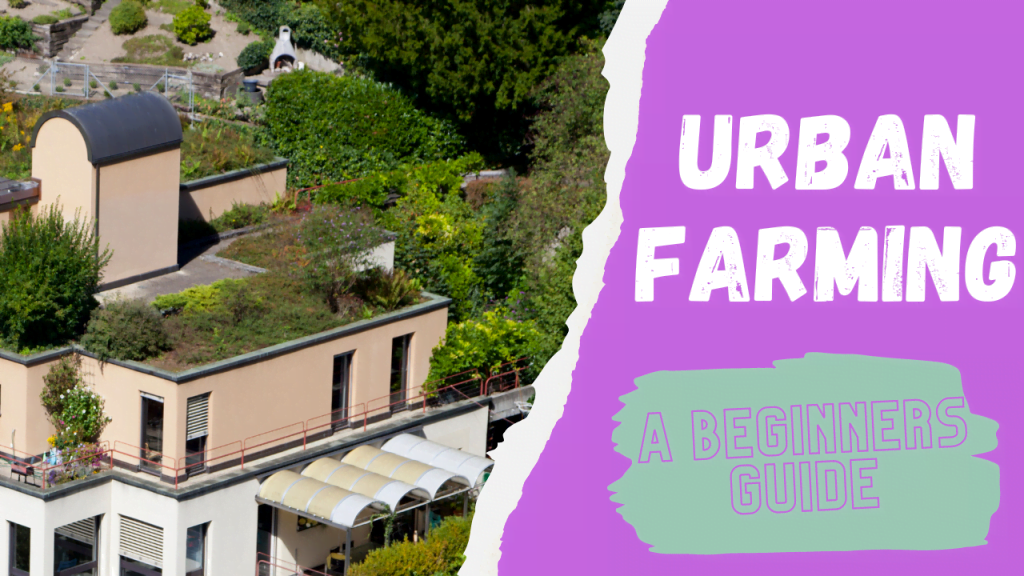Wondering about the world of urban farming and city farms? You’re in for a treat! In this fun, informative guide, we’ll dive deep into the green world of urban agriculture. From the basics of getting started, environmental benefits, and the future of urban farming, we’ve got you covered. So, let’s embark on this exciting journey and explore the wonderful realm of urban farming and city farms together!

Understanding the Difference
Let’s kick things off by getting to know urban farming and city farms a little better. Both terms refer to agricultural practices taking place in sustainable urban environments, but they have some key differences.
Urban farming is a versatile, eco-friendly approach to growing food in urban areas. It comes in various shapes and sizes, including rooftop gardens, vertical farms, and community gardens. Urban farming focuses on utilising available city spaces to increase local food production and promote sustainable living. From amateur green thumbs to professional urban farmers, anyone can get involved and contribute to a greener future!
City farms on the other hand, are larger-scale urban agricultural projects often spearheaded by local governments or non-profit organisations. Covering several acres of land, city farms aim to provide fresh, locally-grown produce to residents and businesses in the surrounding area. They also serve as valuable educational resources and green spaces, fostering community engagement and promoting sustainable agriculture awareness.
Despite their differences in scale and management, urban farming and city farms share common goals such as enhancing food security, promoting sustainability, and reducing food miles. Together, they contribute to a healthier, greener urban lifestyle for all.
Getting Started with Urban Farming
Dreaming of starting your own urban farm? It’s easier than you think! Follow these simple steps and essential tips for beginners to kickstart your urban farming journey:
-
- Choose your space: Whether it’s a balcony, rooftop, or backyard, find a suitable spot with plenty of sunlight and access to water. Don’t have outdoor space? No problem! Indoor gardening with grow lights is also an option.
- Select your plants: Pick plants that are suitable for your climate and space. Start with easy-to-grow vegetables like lettuce, tomatoes, or herbs to build your confidence.
- Gather your tools: Stock up on basic gardening tools such as gloves, a trowel, a watering can, and pruning shears. Investing in quality soil and organic fertilisers is also crucial for healthy plants.
- Plan your garden: Design your urban farm with functionality and aesthetics in mind. Consider using containers, raised beds, or vertical gardening techniques to make the most of your space.
- Learn from the experts: Tap into the wealth of online resources, books, and local workshops to expand your urban farming knowledge. Connect with fellow urban farmers to exchange tips and advice.
- Monitor and maintain: Regularly check on your plants, water them as needed, and protect them from pests and diseases. Patience and persistence are key to a thriving urban farm!
- City Farms Around the World
City Farms Around the World
City farms have been sprouting up around the globe, showcasing innovative approaches to urban agriculture and sustainable food production. Let’s take a look at some successful city farms and what we can learn from them:
-
-
- Brooklyn Grange (New York, USA): Spanning over 2.5 acres across two rooftops, Brooklyn Grange is one of the world’s largest rooftop soil farms. Producing over 50,000 pounds of organic produce annually, this farm demonstrates the potential of rooftop agriculture in dense urban environments.
- The Plant (Chicago, USA): A former meat packing facility turned vertical farm, The Plant houses aquaponic systems, a mushroom farm, and an anaerobic digester for energy production. This innovative project showcases the power of circular economy principles in urban agriculture.
- Stadsboerderij Osdorp (Amsterdam, Netherlands): A community-focused city farm that integrates animal husbandry, vegetable production, and social activities. Stadsboerderij Osdorp emphasises the importance of engaging local residents and fostering a sense of community through urban farming.
- UrbanFarmers AG (Basel, Switzerland): Featuring a rooftop greenhouse and fish farm, UrbanFarmers AG employs aquaponics to produce up to 10 tons of vegetables and 4 tons of fish annually. This pioneering project highlights the potential of closed-loop systems in urban agriculture.
-
These successful city farms teach us the value of innovation, community engagement, and sustainable practices in urban agriculture. By learning from their experiences and adopting similar strategies, we can help shape a greener, healthier future for our cities and beyond.
The Environmental Benefits
Urban farming and city farms play a crucial role in promoting a more sustainable future and a healthier planet. Here’s how these green initiatives make a difference:
-
-
- Reducing food miles: By growing food locally, urban farming and city farms help cut down on transportation-related emissions, thus reducing the overall carbon footprint of food production.
- Enhancing biodiversity: Urban green spaces provide habitats for various plants, insects, and birds, contributing to increased biodiversity within city environments.
- Improving air quality: Plants absorb carbon dioxide and release oxygen, which helps improve air quality in urban areas.
- Managing stormwater: Green spaces, particularly rooftop gardens, can help absorb and filter rainwater, reducing runoff and preventing flooding in cities.
- Reducing urban heat island effect: Green spaces can lower surrounding temperatures by providing shade and releasing moisture through evapotranspiration, mitigating the urban heat island effect.
-
By embracing urban agriculture , we can make significant strides towards a more sustainable future, benefiting both our cities and the planet as a whole.
The Social Impact of Urban Agriculture
Urban agriculture has far-reaching social impacts, fostering community-building and promoting social equity and well-being. These green initiatives create opportunities for people to come together, learn, and grow, while offering numerous benefits for individuals and communities alike.
Building Stronger Communities
City farms often serve as gathering spaces where residents can connect, collaborate, and create lasting friendships. By working together to grow and harvest food, people from diverse backgrounds develop a sense of camaraderie and shared purpose. These green spaces also provide opportunities for intergenerational interaction, enabling valuable knowledge transfer between experienced gardeners and younger generations.
Moreover, urban farmers often host workshops, classes, and events that further strengthen community bonds. These activities encourage continuous learning and skill development, empowering individuals to become more self-sufficient and environmentally conscious.
City farms, in particular, can serve as educational hubs, offering hands-on learning experiences for children and adults. By exposing people to the processes of food production and sustainable agriculture, these farms foster greater appreciation for nature and the importance of environmentally responsible choices.
Promoting Social Equity and Well-being
Urban farming and city farms play a vital role in addressing food insecurity and promoting social equity. By increasing access to fresh, nutritious produce in underserved neighbourhoods, these initiatives help reduce the prevalence of food deserts and promote healthier eating habits.
Furthermore, they create job opportunities and stimulate local economies. By providing training and employment, these initiatives empower individuals to improve their livelihoods while contributing to their communities in a meaningful way.
Lastly, the mental and physical health benefits of urban farming and city farms cannot be overlooked. Gardening activities have been shown to reduce stress, boost mood, and improve overall well-being. Moreover, the physical labour involved in urban farming can serve as a form of exercise, promoting a healthier, more active lifestyle.
By fostering community-building, promoting social equity, and enhancing well-being, urban farming and city farms contribute to the development of thriving, resilient communities for all to enjoy.
Section 6: Challenges and Solutions
While urban farming and city farms offer numerous benefits, they also face challenges that require innovative solutions. Let’s explore some of the main hurdles and how we can address them:
Challenge 1: Limited Space and Resources
One of the most significant challenges in urban agriculture is the limited availability of space and resources. With cities becoming denser, finding suitable areas for farming can be difficult.
Solution: To overcome this challenge, urban farmers can embrace creative solutions such as vertical farming, rooftop gardens, and container gardening. These techniques maximise the use of limited space and can even repurpose underutilised areas like abandoned lots or derelict buildings.
Challenge 2: Soil Contamination
Urban soil can be contaminated with heavy metals and pollutants, which poses risks to both plants and human health.
Solution: Utilising raised beds, container gardening, or hydroponic systems can help mitigate soil contamination risks. Additionally, regular soil testing and remediation techniques like phytoremediation can be employed to ensure a safe and healthy growing environment.
Challenge 3: Water Management
Urban agriculture often relies on municipal water supplies, which can be costly and unsustainable in the long run.
Solution: Implementing water-efficient practices like drip irrigation, rainwater harvesting, and the use of greywater can help conserve water resources and reduce costs. Adopting closed-loop systems, such as aquaponics, can also promote more efficient water usage.
Challenge 4: Legal and Regulatory Barriers
Urban farming and city farms sometimes face legal and regulatory hurdles, including zoning restrictions and a lack of clear policies supporting urban agriculture.
Solution: Advocacy and collaboration with local governments can help create more supportive policies and regulations for urban agriculture. This may include revising zoning codes, offering incentives for urban farming initiatives, and streamlining permit processes.
Challenge 5: Public Awareness and Education
Many people lack awareness of the benefits of urban farming and city farms, which can limit community engagement and support.
Solution: Raising public awareness through educational programs, workshops, and community events can help inform residents about the value of urban agriculture and encourage greater participation. Sharing success stories and best practices can also inspire other communities to adopt similar initiatives.
By addressing these challenges and implementing innovative solutions, urban farming and city farms can continue to flourish and positively impact our urban environments.
Section 7: The Future of Urban Agriculture
As we look ahead, the future of urban farming and city farms appears bright and full of potential. Driven by growing awareness of sustainability, food security, and the need for greener urban spaces, these initiatives will continue to evolve and shape our urban landscapes in several ways:
-
-
- Technological advancements: The integration of cutting-edge technologies like vertical farming, aeroponics, and hydroponics will further optimise resource use and increase crop yields. Smart farming techniques, including sensors and data analytics, will enable more precise and efficient management of urban agriculture.
- Policy support and incentives: As urban farming and city farms gain recognition for their environmental and social benefits, governments and local authorities are likely to develop more supportive policies and incentives to encourage their growth.
- Collaborative networks: Partnerships between urban farmers, city farms, researchers, and industry experts will foster knowledge exchange, innovation, and the development of best practices, further enhancing the potential of urban agriculture.
- Integration into urban planning: Urban agriculture may become an integral component of urban planning, with city farms and green spaces designed into new developments and existing infrastructure. This integration can promote healthier, more sustainable, and resilient urban environments.
-
As urban farming and city farms continue to evolve and adapt, they will play an increasingly significant role in shaping the future of our cities. By embracing these green initiatives, we can cultivate a better tomorrow for ourselves and the planet.




